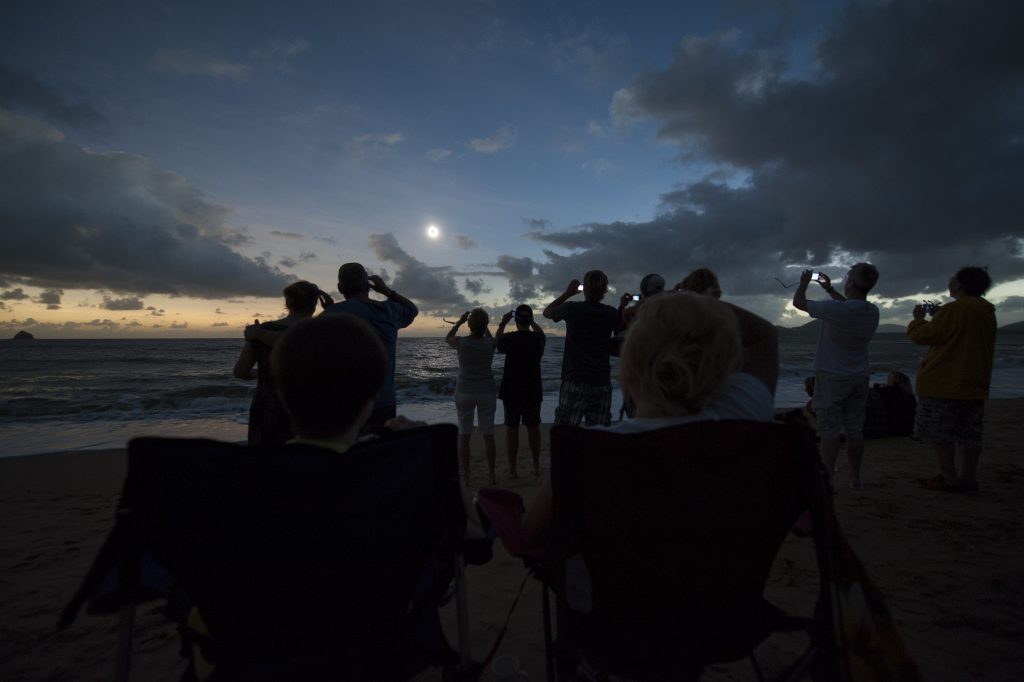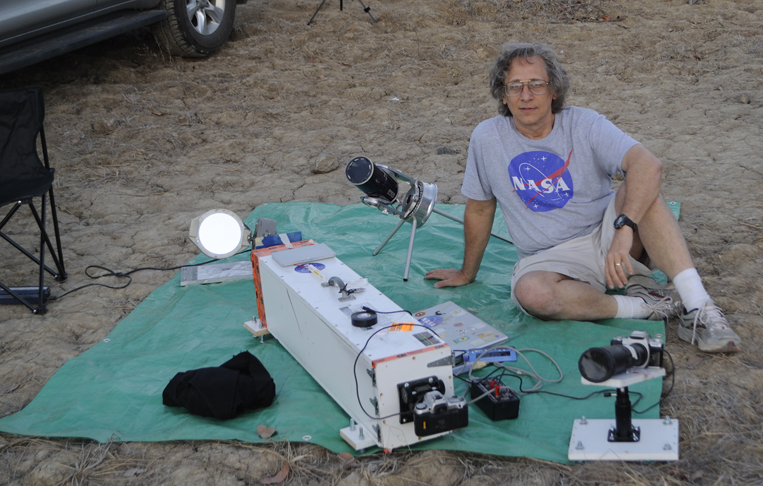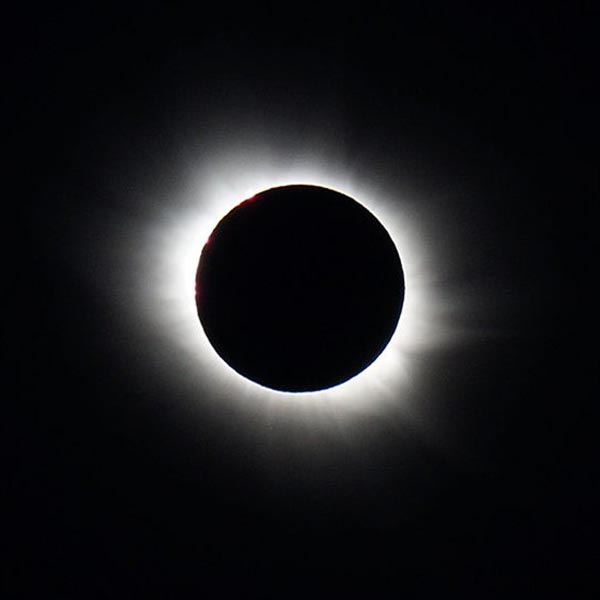The Church of the Solar Eclipse

Glenn Schneider remembers the moment his addiction started in March of 1970. He was 14 years old, and he took a bus trip from New York to North Carolina to watch an eclipse. He had been reading about eclipses for years (since he caught a partial eclipse in 1963) and practicing with his camera to make sure he would be able to capture the moment on film.
But when the moon completely covered the sun—known as totality—Schneider realized just how unprepared he was for the moment. “It completely overwhelmed me,” he says. “There were no words; I was immobilized. I stood there for almost three minutes, staring up at something I had read about for years.” He recalls the darkness bearing down into his soul.
“That’s decoupled from the physical understanding of what is going on,” recalls Schneider, who is an astronomer at the University of Arizona. (He doesn’t study eclipses professionally.) It was so visceral and emotional that he took no pictures and didn’t use his telescope at all as he was enveloped in the phenomenon. “I was shaking, and it changed my life, forever, in a moment. I became an eclipse chaser.”
Schneider’s goal in 1970 was to never miss an eclipse—and he so far has not, with the exception of one in the 1980s. He has witnessed 33 eclipses (making him tied with astronomer Jay Pasachoff for the most eclipses seen in the world), and he’s only been clouded out three times.
There is a community of people who consider themselves “umbraphiles”—Latin for shadow lovers—and they will go to any length to get in the path of darkness during an eclipse. They will be turning their eyes to the sky once more on August 21, when a total solar eclipse sweeps across the U.S.—the first total solar eclipse to cross the contiguous U.S. in a band since 1918. Schneider will be traveling to Madras, Oregon—a town of about 6,000 that is expecting 100,000 people for the big celestial event. It’s statistically one of the best viewing spots in the country, based on information gleaned from historical maps of cloud cover for late August.
Total solar eclipses happen somewhere in the world about once every 18 months, and that gives the hunters an intermittent reward, says Anthony Aveni, an anthropologist and astronomer at Colgate University in Hamilton, New York.
Aveni says that part of eclipse chasing is the desire to belong to something larger than oneself. He compares eclipse enthusiasts to people who pursue storms, because they have their own T-shirts, meetings, and lingo. “When you chase an eclipse, you’re really after a dazzling phenomenon—something off-setting—produced by nature,” says Aveni, author of In the Shadow of the Moon: The Science, Magic, and Mystery of Solar Eclipses. “You want to seek it out for the thrill.”
Although eclipse chasing is generally safer than storm chasing (though one chaser trying to get into the path of totality in Svalbard did get mauled by a polar bear), it still involves a sense of moving as close to an edge as possible. When it comes to eclipses, this means setting up in a location to get the best view possible and avoid cloud cover.
Eclipse chasers like Schneider consult maps and cloud cover estimates to find the best places to witness an eclipse. Getting clouded out is pretty much the worst outcome, he says.
Modern societies aren’t the only ones who have been eclipse obsessed. Eclipses have been recorded by almost every literate culture throughout history.
Schneider studies exoplanetary environments, but when he watches an eclipse, the primal experience is decoupled from his scientific career. Aveni agrees. “I’ve been on enough of these to know that it’s all about being dazzled by nature, even though you know what causes it,” he says. “It still makes the hair on the back of your neck stand up. It’s still unexpected.” Aveni recalls a young woman who made her way over to him after seeing her first eclipse. He could see tears sliding down her face from behind her eclipse glasses. “She said, ‘You explained what was happening, but it’s a miracle to me,’” Aveni recalls.
“Even in this time of scientifically explaining all the myths about nature, when you see an eclipse, it takes you back to the time when people were experiencing something sublime,” Aveni says. After all, the Romantic poets used the word “sublime” to mean simultaneously beautiful and terrifying.
Modern societies aren’t the only ones who have been eclipse obsessed. Eclipses have been recorded by almost every literate culture throughout history. Early Babylonians kept systematic chronicles on clay tablets. In late prehistoric China, astrologers were tasked with advising the emperor on cosmic matters and reputedly could be hanged for failing to anticipate a solar eclipse.
For the pre-Columbian Maya civilization, scientific knowledge of eclipses may have reached new heights. Aveni writes that the Dresden Codex, one of the few surviving documents of pre-Columbian Maya civilization, contains hieroglyphs representing a serpent eating the sun, and numeric inscriptions that seem to indicate a knowledge of the repeating cycle of solar eclipses. Researchers even found an astronomical calendar from the 11th or 12th century that accurately predicted a solar eclipse in 1991 within a day of its occurrence.Modern societies aren’t the only ones who have been eclipse obsessed. Eclipses have been recorded by almost every literate culture throughout history. Early Babylonians kept systematic chronicles on clay tablets. In late prehistoric China, astrologers were tasked with advising the emperor on cosmic matters and reputedly could be hanged for failing to anticipate a solar eclipse.
The unusual lifestyle of eclipse hunting brings with it some ritual behaviors. One chaser had a flag made in 1973 after the eclipse off the coast of Eastern Africa, and the flag has accompanied chasers ever since. And strangely enough, no group carrying the flag has ever been clouded out, according to Schneider. “That flag has always seen clear skies, even while we work hard to try to get into where it is clear,” he says. “It’s just an amazing low-probability event.”
After a successful eclipse viewing, the drink of choice is an egg cream—a concoction of seltzer water, chocolate syrup, and milk. (This tradition is traced back to some New Yorkers, eclipse chasers say.)
Cristine Legare, a cognitive scientist who studies cultural learning at the University of Texas at Austin, isn’t surprised to hear about the rituals of eclipse chasers. “This is just one really cool example of a much bigger phenomenon,” she says.
Legare explains that when there’s a high level of uncertainty—as in trying to see an eclipse—humans tend to use superstitious practices to gain the illusion of exerting control over the world. “It’s not a rejection of the scientific explanation of eclipses,” she says. Viewers are “just fully aware they have no control over it at all.”
These ritualistic practices exist across socioeconomic status and political borders. Legare has found such customs in her research on simpatias—ritualistic cures for common problems like unemployment or infidelity—in Brazil. The more uncertain the outcome, the more common the rituals are—for any situation. “Rituals are part of our psychology because they resonate with our causal reasoning,” Legare says.
In addition, the awe and wonder in nature that eclipse chasers search for and report finding might be a kind of replacement for the spiritual experience that some seek inside organized religion, says Legare. She points out that in many secular countries, there is a high level of New Age spirituality—for example, the Czech Republic has a low level of religiousness but a majority of people believe in fate or the soul. “People are still trying to find some higher meaning and have control over the world. It’s all part of the same psychology.”
The August 21st eclipse is expected to be the most tweeted, shared, and photographed event in human history, according to at least one astronomer. But eclipse chasers will be the first to say that it’s never the same—not even close—to see the sun disappear behind the moon on a screen. You have to be in the path of totality to understand the sublime experience of a total solar eclipse.
Schneider still thinks about the one eclipse he missed since he caught the bug back in 1970. The year was 1985, and he had been doing research at the South Pole. The eclipse’s path was a giant horseshoe around Antarctica, just barely grazing land. He had asked around to see if he could get a ride on a C-130 Hercules transport plane with skis on the bottom, but the conditions were too precarious. “It turned out to be a logistical nightmare,” he says. “That was the one that escaped.”
This year he’ll be in Oregon along with the lucky flag, waiting for his two minutes of awe.



























